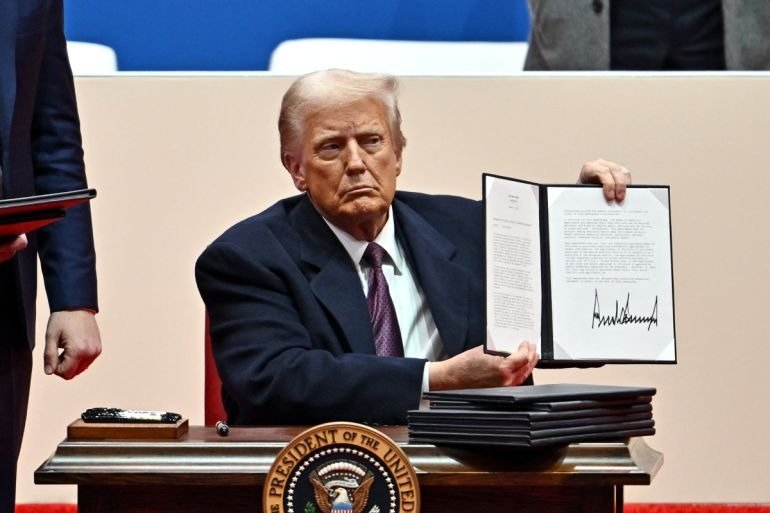What is an executive order, and what orders did Trump sign on day 1?
Donald Trump has signed a flurry of executive actions just after being sworn in as the 47th president of the United States, marking the beginning of his second term.
There are two types of executive actions: executive orders, which are legally binding written orders to the federal government that do not require congressional approval. Presidents also issue proclamations, which are generally not legally binding.
So what’s an executive order and which are the most significant orders Trump signed on Monday?
What are executive orders?
Executive orders are formal written statements outlining the president’s agenda in running the federal government. These can include directives for federal agencies or requests for specific reports. Many orders can be unobjectionable, such as giving federal employees the day after Christmas off, and they can also establish major policies.
New presidents, as the head of the executive branch often do – can issue orders to cancel orders of their predecessors.
Article II of the US Constitution grants the president the power to issue executive orders, according to the American Bar Association (ABA).
“Only a sitting US president may overturn an existing executive order by issuing another executive order to that effect,” the ABA said.
According to the association, these orders don’t need congressional approval and can’t be directly overturned by lawmakers. However, Congress can prevent an order from being carried out by cutting funding or imposing other obstacles.
Trump’s plans for this mandate
‘Securing our borders’
In his inaugural address, Trump promised that “all illegal entry will be halted” and that millions of “criminal aliens” will be deported.
As part of his decisions, Trump declared a national emergency at the US-Mexico border, ordering the deployment of troops to enhance border security.
He resumed the construction of the border wall initiated during his first term in 2017 and reinstated the “Remain in Mexico” programme, which required asylum seekers to wait in Mexico during their US immigration proceedings.
“All illegal entry will immediately be halted. And we will begin the process of returning millions and millions of criminal aliens back to the places from which they came,” Trump said. His administration also shut down an app used for immigration appointments and said existing appointments were cancelled.
He announced intentions to end birthright citizenship for the children of undocumented immigrants.
Birthright citizenship, which guarantees citizenship to anyone born on US soil, is protected by the 14th Amendment and any attempt to revoke it will likely bring immediate legal challenges.
Trump also designated cartels and international gangs as “global terrorists,” expanding governmental powers to combat human trafficking and drug smuggling. He also promised to “eliminate the presence of all foreign gangs and criminal networks” in the US.
“You can do whatever you have to do to get out of that problem and we do have that kind of emergency,” Trump said late on Monday.
Pardons in the January 6 US Capitol attack
Trump also issued a proclamation to pardon approximately 1,500 individuals convicted in relation to the January 6, 2021 Capitol attack, and ended federal cases against political opponents of the outgoing administration.
“This proclamation ends a grave national injustice that has been perpetrated upon the American people over the last four years and begins a process of national reconciliation,” Trump said in a statement published on the White House website.
Trump’s pardons wiped the slate clean for many of those convicted of committing the most serious crimes on January 6, including Enrique Tarrio, the former leader of the far-right Proud Boys, who was sentenced to 22 years in prison for seditious conspiracy.
The pardons also erased the criminal records of more than 700 people convicted of misdemeanour offences, such as trespassing, and put a halt to hundreds of pending prosecutions.
Separately, Trump directed the end of federal cases against “political opponents” of the Biden administration, specifically targeting cases involving his supporters.
‘Restoring biological truth’: Redefining gender roles
Another major decision was an order to the federal government to only recognise two sexes, male and female. This is in line with his rhetoric against “woke” culture.
“As of today, it will henceforth be the official policy of the United States government that there are only two genders, male and female,” Trump said during his inaugural address.
“Sex shall refer to an individual’s immutable biological classification as either male or female,” the order says. “Sex” is not a synonym for and does not include the concept of “gender identity”.
Pausing the TikTok ban
Trump also signed an executive order to suspend a law banning TikTok temporarily.
The order pauses the law for 75 days, allowing companies collaborating with TikTok to avoid legal consequences during this period.
The order stated that this pause aims to provide the administration with time “to pursue a resolution that protects national security while saving a platform used by 170 million Americans”.
“Essentially, with TikTok, I have the right to sell it or close it, and we’ll make that determination, and we may have to get approval from China, too. I’m not sure, but I’m sure they’ll approve it,” he said.
He also said his administration will work on “a joint venture” between the US and undisclosed other entities. “I think you have a lot of people that would be interested in TikTok with the United States as a partner,” he added.
Withdrawing from the WHO and Paris climate agreement
According to the new executive order, Trump is pulling the US out of the World Health Organization (WHO) and the Paris Agreement.
“World Health ripped us off, everybody rips off the United States. It’s not going to happen any more,” Trump said while signing the order.
The US plans to withdraw within 12 months and cease all financial contributions to its operations. As the largest financial supporter of the United Nations health agency, this decision marks a significant shift.
He also signed an order to quit the “unfair one-sided Paris climate accord rip off”. It’s a major setback for the fight against climate change in the United States, the world’s second-largest greenhouse gas emitter.
At the Paris UN climate summit in 2016, countries pledged to cut fossil fuels as part of a global response to the threat of climate change.
Trump had pulled out of the landmark climate accord during his first term – a decision reversed by his predecessor Joe Biden, who had promised to achieve net-zero emissions by 2050 under a $2 trillion plan to transform the economy.
The US president declared an energy emergency as he promised to “drill, baby, drill,” and said he would eliminate what he calls Biden’s electric vehicle mandate.
Renaming the Gulf of Mexico, and the Denali
Trump also ordered to change names of the Gulf of Mexico and Alaska’s mountain Denali.
“A short time from now, we are going to be changing the name of the Gulf of Mexico to the Gulf of America,” the US president said on Monday shortly after he was sworn in.
The US president also issued an order to revert the name of Denali, the highest mountain in North America, to Mount McKinley. In 2015, President Barack Obama changed the name to Denali located in Alaska to reflect its native roots.
Federal hiring process
Trump has also frozen federal government hiring, with exceptions for the military and unspecified other sectors. He has also paused the introduction of new federal regulations as he works to establish his second administration.
The order seeks the “efficient use of existing personnel and funds to improve public services and the delivery of these services”.
He has also officially tasked the Department of Government Efficiency (DOGE), led by Elon Musk, with streamlining government operations.

